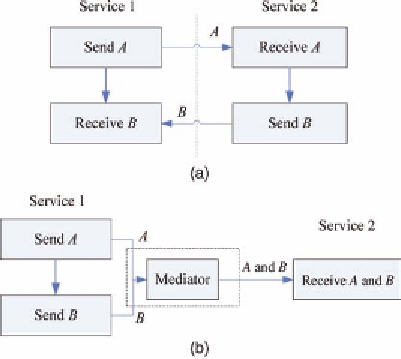Information Technology Reference
In-Depth Information
Figure 4.1
(a) Direct composition and (b) mediation-aided composition.
is sitting in between their interaction. It is also correct because both
services can terminate properly. In Figure 4.1b, Service 1 first sends A
and then sends B; Service 2 waits for A and B to arrive simultaneously.
Services 1 and 2 cannot be directly composed by simply adding links
because Service 1 has two interfaces while Service 2 has only one. In
this case we can add a module (i.e., mediator) between them. Its
function is to combine messages A and B coming from Service 1
and forward it to Service 2. With the aid of this mediator, Services 1 and
2 can be composed and interact correctly.
Figure 4.1b presents a rather simple case of mediation-aided
composition, and later, we present more powerful mediators that can
intercept, store, transform, and forward messages between services.
In our work, we use colored Petri nets (CPNs) as an underlying
formalism. This model provides not only a formalism to depict the
internal logic and the message exchange behavior, but also rich analysis
capability to support the solid verification of compatibility and media-
tion existence.
There is neither formal analysis on the existence of mediation nor
methods to derive the mediator for two partially compatible BPELWeb
services. In contrast, with the existing approaches assuming aWeb service
as a set of independent operations, our approach takes into account the
conversational nature of Web services. We take the de facto standard, that


